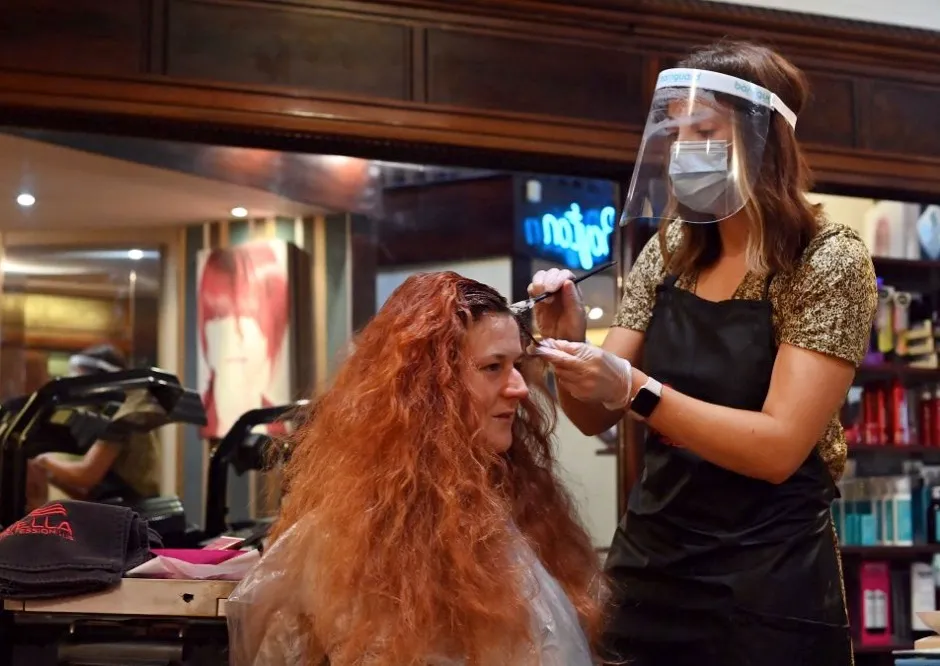Hairdressers and barbers should wear face coverings and not just visors, in order to help curb the spread of coronavirus, scientists advising the government say.
The experts warn that plastic face shields being used in hair salons are unlikely to be an effective control for aerosol transmission of COVID-19.
Read the latest coronavirus news:
- COVID-19: Asymptomatic carriers should self-isolate ‘regardless of symptoms’
- Drinking in pubs creates "perfect storm" for spreading coronavirus
- Second COVID-19 wave could be twice as high without contact tracing
In documents released by the Scientific Advisory Group for Emergencies (Sage) on Friday, the New and Emerging Respiratory Virus Threats Advisory Group (Nervtag) says the guidance needs to change.
The group says face shields provide protection for the wearer against large droplet exposure, including by inoculation through the eyes.
However, they are unlikely to provide any protection for the wearer against small aerosols.

There is no evidence that face shields/visors are an effective source control for either larger droplets or small aerosols, the document published on Friday sets out.
In the paper from 22 July, the scientists advise: “It is recommended that guidance for settings where people are in close proximity for a long duration (eg hairdressing), and that currently only require face shields to be worn, should be changed to include the wearing of face coverings.”
In England hairdressers reopened on 4 July, after being closed for about three months, with appropriate measures in place to keep staff and clients safe, but without the requirement for face coverings.
More on coronavirus transmission:
- Cats and coronavirus: Is my pet at risk of COVID-19?
- Coronavirus: reducing distance to one metre increases transmission risk
- Washing your hands six to 10 times a day could lower coronavirus risk
In relation to those providing close contact services, such as hairdressers, barbers and beauty salons, the current government guidance sets out: “In workplaces such as hairdressers and barbers, spas, beauty salons, tattoo and photoshoot studios, it is likely to be difficult to maintain social distancing, as employees need to work in close proximity to their clients, usually for an extended period of time.”
It continues: “The person providing a service (such as hairdressers or beauticians, because of the period of time spent in close proximity to a person’s face, mouth and nose) should therefore wear further protection in addition to any that they might usually wear.
“This should take the form of a clear visor that covers the face and provides a barrier between the wearer and the client from respiratory droplets caused by sneezing, coughing or speaking.
“Visors must fit the user and be worn properly. It should cover the forehead, extend below the chin, and wrap around the side of the face.”
In the document released by Sage, the scientists note that an anecdotal report from an outbreak in Switzerland has suggested those wearing face shields were more likely to be infected than those wearing masks.
However they warn this should be treated with caution as the outbreak investigation has not yet formally reported.
Scientists also recommend in their report that: “Steps should be taken to ensure good ventilation in all buildings to mitigate aerosol transmission.
“Priority should be given to spaces where ventilation is absent or inadequate, those where there are several people in close proximity for a period of 30 minutes or more and those where an infectious person is more likely to be present (e.g. GP surgeries, pharmacies).”
Q&A: What is the R number, and why is it relevant to coronavirus?
The reproduction number – often called the R value or R number – is a measure of a disease’s ability to spread. It tells us how many people a single infected person will pass on the disease to.
The R number for COVID-19 that’s being quoted in the media and government briefings is what’s known as the ‘effective’ reproduction number. This value can go up and down.
We can reduce R by making it harder for the disease to spread, by implementing measures such as social distancing, closing restaurants and non-essential shops, and encouraging people to stay at home.
Every disease also has what’s called a ‘basic’ reproduction number, R0, which is the fixed value of R if no measures are put in place. For example, measles is highly contagious, with a R0 as high as 18, while COVID-19 has a R0 of around three.
So if COVID-19 was allowed to spread through the population, an infected person would, on average, give the disease to three other people.
But if all these people are practising physical distancing, then the virus can’t spread so easily and the effective R value goes down.
The crucial thing is to keep R below 1. If we can do this, then the number of new cases dwindles and the outbreak will eventually come to a halt.
Conversely, if R rises above 1, then we run the risk of rapidly escalating case numbers that would require stronger measures to keep the virus under control.
Because of this, R is used by governments to assess how we are doing in our efforts to stop the spread of COVID-19, and to adjust our actions, if needed.
Read more:
